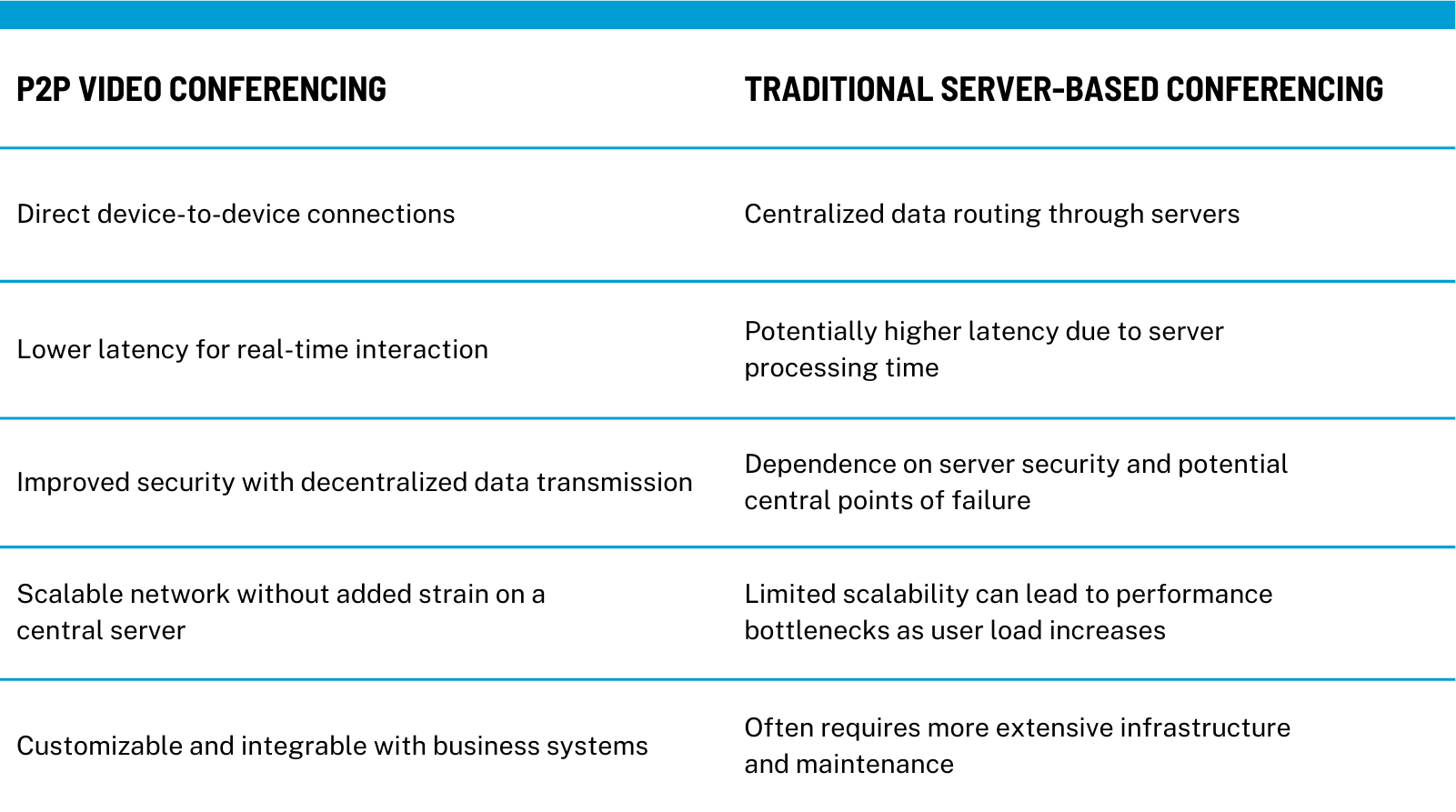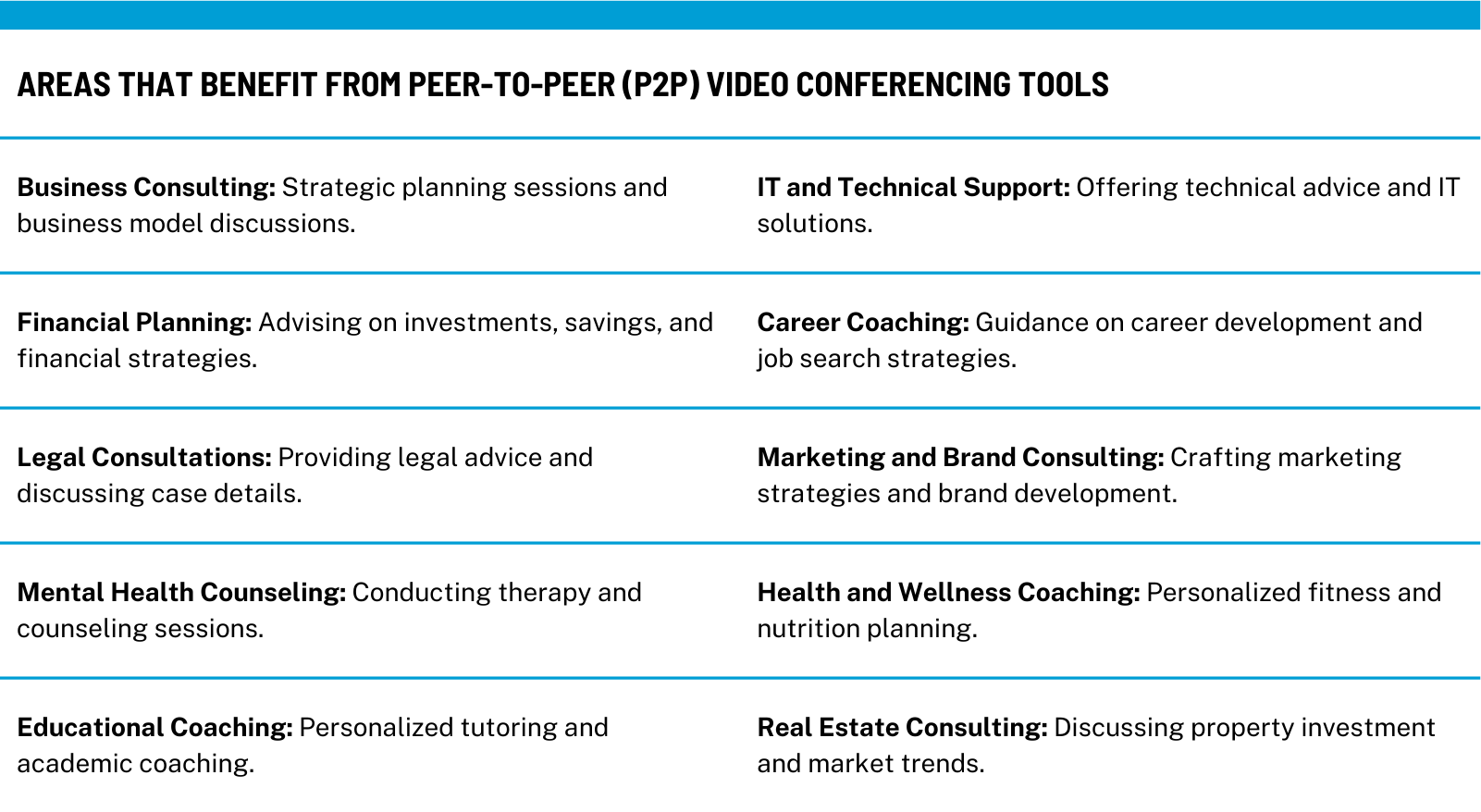In response to the COVID-19 pandemic, the world experienced a surge in the need for digital communication. This challenging period highlighted the critical importance of secure, efficient online communication tools. P2P (Peer-to-Peer) video conferencing emerged as a key technology, providing robust solutions for these evolving demands.
P2P technology not only facilitated uninterrupted business operations but also enabled personal connections in times of social distancing. For comprehensive insights into PPM video, audio, messaging, and chat solutions that have adapted to these challenges, explore our detailed resources.
What is Peer-to-Peer Video Conferencing?
P2P video conferencing, often utilizing WebRTC technology, allows direct device-to-device communication for audio and video data transmission. This method offers an efficient exchange of information, unbound by traditional server-based constraints. WebRTC enhances the reliability and real-time communication effectiveness in P2P conferencing. This technology aligns with modern business needs, especially for those seeking innovative solutions like video conferencing apps with integrated payments, combining the convenience of digital transactions with the immediacy of direct communication.
How Does P2P Differ from Traditional Server-Based Solutions?
- Server Dependency vs. Direct Connectivity: Traditional systems rely on central servers, which can lead to performance bottlenecks. P2P conferencing, by eliminating this dependency, creates a more efficient network. However, it’s important to recognize the reliability and robust infrastructure offered by traditional server-based systems, especially beneficial in environments requiring centralized control and management.
- Performance and Scalability: Server-based systems often struggle under increased load, while P2P networks efficiently scale, enhancing performance as more participants join.
- Latency Concerns: P2P conferencing is notable for its lower latency, providing a near real-time experience, unlike traditional models where data traversal through multiple nodes causes delays.
How Does P2P Compare to Mass Consumer Video Conferencing Products?
- Customization and Business Integration: P2P solutions offer customization and can be seamlessly integrated into existing business systems, in contrast to the generic nature of mass consumer products. Yet, mass consumer products provide user-friendly, ready-to-use solutions that cater well to individual users or organizations that prioritize simplicity and quick setup.
- Security and Privacy: P2P conferencing ensures enhanced security and privacy, as it does not involve central data storage or routing, a common concern with consumer-grade solutions.
- Business-Centric Features: Designed with business needs in mind, P2P solutions offer superior integration capabilities and customization options, which are often lacking in ready-to-use consumer products.

How Does P2P Video Conferencing Work?
P2P video conferencing utilizes direct connections between users’ devices, a key aspect that differentiates it from traditional models. Here’s how it works:
Utilizing WebRTC: At its core, P2P conferencing often relies on WebRTC technology. WebRTC facilitates real-time communication directly in web browsers without the need for external plugins or software. It enables seamless audio and video communication, crucial for P2P setups.
Establishing Direct Connections: Unlike traditional models where data passes through a central server, P2P establishes a direct connection between participants. This method significantly reduces the distance data must travel, thereby reducing latency and potential points of failure.
Dynamic Data Routing: In P2P networks, data is dynamically routed between peers. If one route becomes inefficient or fails, the network can quickly adapt, choosing a new path for data transmission. This flexibility is absent in traditional models, which rely on static server-based routing.
Scalable Network Structure: Each participant in a P2P network acts as both a client and a server, sharing the load. As more participants join, the network’s capacity naturally scales, which contrasts with traditional models where adding more users can strain the server resources.
Security Protocols: P2P networks implement robust security protocols. Since data is not centrally stored, the risk of data breaches is minimized. WebRTC also includes built-in encryption for data transmission, enhancing security.
P2P Video Conferencing in Different Industries
Healthcare: Comprehensive Telehealth Solutions
P2P conferencing in healthcare extends beyond doctor-patient consultations to include multidisciplinary team meetings and remote patient monitoring. This technology can facilitate collaborative care, allowing various specialists to confer on a patient’s treatment plan in real time.
For patients, this means access to a broader range of specialists and more coordinated care. The ability to include an integrated payment system also simplifies the process of handling co-pays or consultation fees, making telehealth more accessible and user-friendly.
Education: Creating a Virtual Campus Experience
In education, P2P conferencing can replicate a virtual campus environment where not only are classes held online, but students can also engage in group activities, peer-to-peer collaboration, and access to counseling services. This technology can make distance learning more immersive and interactive, helping bridge the gap between traditional and online education.
Consulting Business: Enhancing Global Reach and Efficiency
For consultants, P2P conferencing technology can be a gateway to global markets, allowing them to offer their services worldwide without geographical limitations. It also allows businesses to monetize the time of experts much more efficiently, without having to rely on offline face-to-face visits, increasing customer turnover, broadening target audience, and creating better prospects for generating profits for the company and its employed experts alike.
The high-quality, secure communication channel is ideal for sensitive business consultations, legal advice, or financial planning services. The integrated payment feature further adds to the efficiency by enabling quick and secure financial transactions across different currencies, which is essential for consultants with a diverse international clientele.

Realizing Business Potential with P2P Video Conferencing
In today’s rapidly evolving business landscape, P2P video conferencing is not just a communication tool; it’s a catalyst for business growth and efficiency. Let’s explore how this technology can propel your business forward:
- Seamless Integration with Existing Systems: P2P conferencing solutions are designed to integrate effortlessly into your current business environment. This compatibility minimizes disruptions and enhances existing workflows, making the transition smooth and efficient.
- Flexible Deployment Options: Whether your preference is cloud-based solutions for their scalability and accessibility, or on-premises setups for greater control and security, P2P conferencing offers the flexibility to suit your business needs. This adaptability ensures that businesses of all sizes can find a fitting solution.
- Versatility Across Business Models: Catering to a wide array of business structures, from B2B and B2C to C2C, P2P conferencing technology adapts to various operational models. This versatility makes it a valuable asset regardless of your customer base or service delivery method.
- Enhanced Security and Compliance: With end-to-end encryption and adherence to international data protection regulations like GDPR and HIPAA, P2P conferencing provides a secure platform for your business communications. This commitment to security and privacy not only protects your data but also builds trust with your clients.
By embracing P2P video conferencing technology, businesses can leverage these tangible benefits to enhance communication, streamline operations, and provide superior service, all while ensuring security and compliance in a digital-first world.
The Takeaway
P2P video conferencing is more than just a technological innovation; it’s a transformative tool for modern businesses. With its direct device-to-device communication enabled by WebRTC, P2P conferencing offers unparalleled efficiency, security, and flexibility. From enhancing telemedicine in healthcare to revolutionizing online learning in education, and from streamlining client engagement in consulting to providing comprehensive solutions for various industries, these solutions are tailored to meet diverse needs.
Your business stands to benefit significantly from the adoption of P2P technology. If you’re looking to learn more, access detailed case studies, or are planning to implement this technology in your product or business operations, we’re here to assist. Contact us to explore how our P2P video conferencing solutions can elevate your business and help you stay ahead in a digitally connected world.